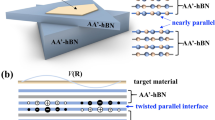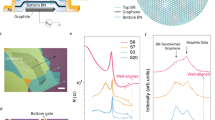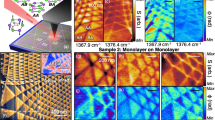Abstract
Moiré superlattices host a rich variety of correlated electronic phases. However, the moiré potential is fixed by interlayer coupling, and it is dependent on the nature of carriers and valleys. In contrast, it has been predicted that twisted hexagonal boron nitride (hBN) layers can impose a periodic electrostatic potential capable of engineering the properties of adjacent functional layers. Here, we show that this potential is described by a theory of electric polarization originating from the interfacial charge redistribution, validated by its dependence on supercell sizes and distance from the twisted interfaces. This enables controllability of the potential depth and profile by controlling the twist angles between the two interfaces. Employing this approach, we further demonstrate how the electrostatic potential from a twisted hBN substrate impedes exciton diffusion in semiconductor monolayers, suggesting opportunities for engineering the properties of adjacent functional layers using the surface potential of a twisted hBN substrate.
This is a preview of subscription content, access via your institution
Access options
Access Nature and 54 other Nature Portfolio journals
Get Nature+, our best-value online-access subscription
$29.99 / 30 days
cancel any time
Subscribe to this journal
Receive 12 print issues and online access
$259.00 per year
only $21.58 per issue
Buy this article
- Purchase on Springer Link
- Instant access to full article PDF
Prices may be subject to local taxes which are calculated during checkout




Similar content being viewed by others
Data availability
Source data are provided with this paper. Source data are also available at https://doi.org/10.5281/zenodo.8121595. The data that support the plots within this paper and other findings of this study are available from the corresponding authors upon reasonable request.
References
Andrei, E. Y. & MacDonald, A. H. Graphene bilayers with a twist. Nat. Mater. 19, 1265–1275 (2020).
Yankowitz, M., Ma, Q., Jarillo-Herrero, P. & LeRoy, B. J. van der Waals heterostructures combining graphene and hexagonal boron nitride. Nat. Rev. Phys. 1, 112–125 (2019).
Balents, L., Dean, C. R., Efetov, D. K. & Young, A. F. Superconductivity and strong correlations in moiré flat bands. Nat. Phys. 16, 725–733 (2020).
Mak, K. F. & Shan, J. Semiconductor moiré materials. Nat. Nanotechnol. 17, 686–695 (2022).
Wilson, N. P., Yao, W., Shan, J. & Xu, X. Excitons and emergent quantum phenomena in stacked 2D semiconductors. Nature 599, 383–392 (2021).
Kennes, D. M. et al. Moiré heterostructures as a condensed-matter quantum simulator. Nat. Phys. 17, 155–163 (2021).
Huang, D., Choi, J., Shih, C.-K. & Li, X. Excitons in semiconductor moiré superlattices. Nat. Nanotechnol. 17, 227–238 (2022).
Xue, J. et al. Scanning tunnelling microscopy and spectroscopy of ultra-flat graphene on hexagonal boron nitride. Nat. Mater. 10, 282–285 (2011).
Lee, G.-H. et al. Highly stable, dual-gated MoS2 transistors encapsulated by hexagonal boron nitride with gate-controllable contact, resistance, and threshold voltage. ACS Nano 9, 7019–7026 (2015).
Britnell, L. et al. Electron tunneling through ultrathin boron nitride crystalline barriers. Nano Lett. 12, 1707–1710 (2012).
Dean, C. R. et al. Boron nitride substrates for high-quality graphene electronics. Nat. Nanotechnol. 5, 722–726 (2010).
Wang, Z. et al. Composite super-moiré lattices in double-aligned graphene heterostructures. Sci. Adv. 5, eaay8897 (2019).
Caldwell, J. D. et al. Photonics with hexagonal boron nitride. Nat. Rev. Mater. 4, 552–567 (2019).
Li, P. et al. Hyperbolic phonon-polaritons in boron nitride for near-field optical imaging and focusing. Nat. Commun. 6, 7507 (2015).
Tran, T. T., Bray, K., Ford, M. J., Toth, M. & Aharonovich, I. Quantum emission from hexagonal boron nitride monolayers. Nat. Nanotechnol. 11, 37–41 (2016).
Maity, A., Grenadier, S. J., Li, J., Lin, J. Y. & Jiang, H. X. Hexagonal boron nitride neutron detectors with high detection efficiencies. J. Appl. Phys. 123, 044501 (2018).
Yasuda, K., Wang, X., Watanabe, K., Taniguchi, T. & Jarillo-Herrero, P. Stacking-engineered ferroelectricity in bilayer boron nitride. Science 372, 1458–1462 (2021).
Vizner Stern, M. et al. Interfacial ferroelectricity by van der Waals sliding. Science 372, 1462–1466 (2021).
Woods, C. R. et al. Charge-polarized interfacial superlattices in marginally twisted hexagonal boron nitride. Nat. Commun. 12, 347 (2021).
Moore, S. L. et al. Nanoscale lattice dynamics in hexagonal boron nitride moiré superlattices. Nat. Commun. 12, 5741 (2021).
Chiodini, S. et al. Moiré modulation of van der Waals potential in twisted hexagonal boron nitride. ACS Nano 16, 7589–7604 (2022).
Zhao, P., Xiao, C. & Yao, W. Universal superlattice potential for 2D materials from twisted interface inside h-BN substrate. npj 2D Mater. Appl. 5, 38 (2021).
Chang, J. S. et al. Graphene nanoribbons with atomically sharp edges produced by AFM induced self-folding. Small 14, 1803386 (2018).
Jiang, Y. et al. Electron ptychography of 2D materials to deep sub-ängström resolution. Nature 559, 343–349 (2018).
Shabani, S. et al. Deep moiré potentials in twisted transition metal dichalcogenide bilayers. Nat. Phys. 17, 720–725 (2021).
Zerweck, U., Loppacher, C., Otto, T., Grafström, S. & Eng, L. M. Accuracy and resolution limits of Kelvin probe force microscopy. Phys. Rev. B 71, 125424 (2005).
Deb, S. et al. Cumulative polarization in conductive interfacial ferroelectrics. Nature 612, 465–469 (2022).
Choi, J. et al. Moiré potential impedes interlayer exciton diffusion in van der Waals heterostructures. Sci. Adv. 6, eaba8866 (2020).
Choi, J. et al. Twist angle-dependent interlayer exciton lifetimes in van der Waals heterostructures. Phys. Rev. Lett. 126, 047401 (2021).
Wagner, K. et al. Nonclassical exciton diffusion in monolayer WSe2. Phys. Rev. Lett. 127, 076801 (2021).
Xu, Y. et al. Creation of moiré bands in a monolayer semiconductor by spatially periodic dielectric screening. Nat. Mater. 20, 645–649 (2021).
Miyahara, Y. & Grutter, P. Force-gradient sensitive Kelvin probe force microscopy by dissipative electrostatic force modulation. Appl. Phys. Lett. 110, 163103 (2017).
Axt, A., Hermes, I. M., Bergmann, V. W., Tausendpfund, N. & Weber, S. A. L. Know your full potential: quantitative Kelvin probe force microscopy on nanoscale electrical devices. Beilstein J. Nanotechnol. 9, 1809–1819 (2018).
Kresse, G. & Furthmüller, J. Efficiency of ab-initio total energy calculations for metals and semiconductors using a plane-wave basis set. Comput. Mater. Sci. 6, 15–50 (1996).
Kresse, G. & Furthmüller, J. Efficient iterative schemes for ab initio total-energy calculations using a plane-wave basis set. Phys. Rev. B 54, 11169–11186 (1996).
King-Smith, R. D. & Vanderbilt, D. Theory of polarization of crystalline solids. Phys. Rev. B 47, 1651–1654 (1993).
Ghorashi, S. A. A. et al. Topological and stacked flat bands in bilayer graphene with a superlattice potential. Phys. Rev. Lett. 130, 196201 (2023).
Quan, J. et al. Phonon renormalization in reconstructed MoS2 moiré superlattices. Nat. Mater. 20, 1100–1105 (2021).
Acknowledgements
The experiments are primarily supported by the Air Force Office of Scientific Research under award No. FA2386-21-1-4067 (D.S.K.), National Science Foundation (NSF) Grant No. ECCS-2130552 (Z.L.) and the Department of Energy, Office of Basic Energy Sciences under grant DE-SC0019398 (Y.N.). The work by R.M-L. and R.C.D. is supported by the NSF Partnership for Research and Education in Materials via the Division for Materials Research (DMR; award No. DMR-2122041). Y.M. acknowledges the support of NSF CAREER (grant No. DMR-2044920) and the NSF Major Research Instrumentation (MRI) program (grant No. DMR-2117438). X.L. gratefully acknowledges the Welch Foundation grant No. F-1662 for support in sample preparation. The collaboration between UT-Austin (S.A.) and Washington University was enabled by NSF Designing Materials to Revolutionize and Engineer our Future program via grants No. DMR-2118806 and DMR-2118779. The collaboration between X.L., C.S. and K.L. was enabled by the NSF through the Center for Dynamics and Control of Materials via the NSF Materials Research Science and Engineering Centers (Cooperative Agreement No. DMR-1720595), which also supported the user facility where part of the experiments were performed. The MRI program DMR-2019130 (F.G.) supported some experiments. K.W. and T.Taniguchi. acknowledge support from the Japan Society for the Promotion of Science (KAKENHI grant Nos. 20H00354, 21H05233 and 23H02052) and the World Premier International Research Center Initiative, MEXT, Japan. W.Y. acknowledges support from the Research Grants Council of the Hong Kong Special Administrative Region (grant No. HKU SRFS2122-7S05) and the Croucher Foundation.
Author information
Authors and Affiliations
Contributions
D.S.K., X.L. and Y.M. conceived the experiment. D.S.K. fabricated the samples with assistance from Y.N., Z.L., F.Y.G. and S.A. for sample characterizations. D.S.K., R.M-L. and R.C.D. carried out atomic force microscopy and KPFM experiments with contributions from M.F. D.S.K. performed the optical measurements with contributions from J.E. K.W. and T.Taniguchi. synthesized the bulk crystals. D.Y., T.Tan., W.Y. and L.Y. proposed the theoretical model and performed the first-principles calculations. D.S.K. analysed the data with contributions from R.M.L. and D.Y. D.S.K., S.K., C.K.S., K.L., W.Y., L.Y., Y.M. and X.L. wrote the first draft of the manuscript. All authors contributed to discussions.
Corresponding authors
Ethics declarations
Competing interests
The authors declare no competing interests.
Peer review
Peer review information
Nature Materials thanks Weibo Gao, Olga Kazakova and the other, anonymous, reviewer(s) for their contribution to the peer review of this work.
Additional information
Publisher’s note Springer Nature remains neutral with regard to jurisdictional claims in published maps and institutional affiliations.
Extended data
Extended Data Fig. 1 Introduction of folding and folded hBN flakes.
a, Illustration of folding along the zigzag (armchair) direction leading to the parallel (anti-parallel) orientation at the interface. Optical image of one ~ 4 nm thick hBN flake (b) before and (c) after folding. Scale bars represent 5 μm. The folded regions are marked by dashed lines with different colour contrasts. The blue and red dashed lines encircle the bilayer and trilayer regions in (c), respectively.
Extended Data Fig. 2 Parameter dependence of KPFM measurements.
a, Illustration of the tip scanning over the sample. Scan height h is the sum of the thickness of the top hBN, z = 7.8 nm, and tip-to-sample distance, zlift. b is the domain size as defined in the main text. b, Measured modulation potential depth ΔVs as a function of the scan height, h, for two domain sizes of 60 nm (blue sphere) and 370 nm (red sphere). The measured potential depth remains constant for large supercells while drops for small supercells with increasing scan height. It is important to note that the potential can be sensitive to scan height even for large supercells with a blunt tip and a reduced spatial resolution. The tip-to-sample distance is kept at zlift = 2 nm for all results presented in the main text. c, Potential modulation as a function of scan speed for a supercell of 60 nm period. The potential value does not change remarkably for the scan speed between 0.5 and 1.5 Hz. The images presented in the main text are taken at the scan speed of 1 Hz. All error bars represent the root mean square error from the sinusoidal fitting to KPFM measurements. d-f, KPFM images of the domains with supercell size of 60 nm (d, e) and 370 nm (f). The images (d) and (e) are identical images but represented on two different potential scales. The potential scale of (e) is chosen to be the same as that of (f) for comparison. Notice that several small features with higher potential are clearly resolved in (d) and (e), which is indicative of a high spatial resolution. The measurements were performed by a supersharp diamond-like carbon tip with a radius of 1 nm.
Extended Data Fig. 3 Top hBN layer thickness dependent potential modulation.
a, KPFM images of single (dashed blue) and double (dashed red) moiré superlattices. Scale bar represents 500 nm. b, Schematic of the sample in (a). c, Surface potentials measured from the single (blue) and double (red) moiré regions. The ferroelectric interface (the bottom interface) lies between layers with δ ~ 0∘ while the contribution from the second interface with δ ~ 16∘ is negligible. The shallower potential from the double moiré region is due to the effectively thicker hBN layer. The blue and red lines plotted the theory curve with measured hBN thickness from the bottom interface. d, Summary of potential modulation as a function of the top hBN thickness. Data points were collected from several samples with the same supercell sizes of 130 nm and 290 nm. All error bars represent the root mean square error from the sinusoidal fitting to KPFM measurements.
Extended Data Fig. 4 Supercell shape influencing modulation potential.
a, Illustration of an isosceles triangular supercell. The base length is fixed at 240 nm and sides are defined as the period in panel (b). b, The modulation potential measured from several isosceles triangular supercells. In regions where supercells are distorted by unintentional strain, equilateral triangles become isosceles triangles. In this case, the extracted potential (blue spheres) deviates from the theoretical prediction (solid curve). The vertical red dashed line corresponds to the period of 240 nm, that is an equilateral triangle. Error bars represent the root mean square error from the sinusoidal fitting to KPFM measurements.
Extended Data Fig. 5 Diffusion measurements in multiple locations on the ML MoSe2/t-hBN.
a-c, Normalized pump-probe images from the second position on the ML MoSe2/t-hBN at delay times 0 ps (a), 2.5 ps (b), and 5 ps (c). The scale bar is 1 μm. d, Line profiles taken along the white dashed lines in (a-c). The solid lines are Gaussian fittings. e-h, Corresponding images and line profiles from the third position on the ML MoSe2/t-hBN. The solid lines are Gaussian fittings. The grey dashed lines represent the laser profile. The exciton density is the same as the main text of ~ 7 × 1011 cm−2.
Extended Data Fig. 6 Diffusion measurements with different exciton densities on the ML MoSe2/t-hBN.
a-c, Normalized pump-probe images on the ML MoSe2/t-hBN with exciton density of ~ 3 × 1011 cm−2 at delay times 0 ps (a), 5 ps (b), and 10 ps (c). The scale bar is 1 μm. d, Line profiles taken along the white dashed lines in (a-c). The solid lines are Gaussian fittings. e-h, Corresponding images and line profiles from the ML MoSe2/t-hBN substrate with exciton density of ~ 2 × 1012 cm−2. The solid lines are Gaussian fittings. The grey dashed lines represent the laser profile at exciton density of ~ 7 × 1011 cm−2.
Extended Data Fig. 7 Non-trivial topological states in bilayer graphene induced by t-hBN.
a, Proposed device structure to control band topology of a natural bilayer graphene by t-hBN substrate with a gate voltage V0. b, Phase diagram of the bilayer graphene under the moiré potential generated by t-hBN as a function of the applied bias V0 and the period of the moiré potential, b. Within the shaded area, the highest valence band (marked by red in b–e) is topologically non-trivial. Outside this area, the highest valence band is either trivial or does not have a well-defined gap with other bands. c-f, Dispersion relation of the bilayer graphene corresponding to several representative points of the phase diagram. c, V0 = 60 meV, b = 12 nm. d, V0 = 60 meV, b = 25 nm. e, V0 = 50 meV, b = 25 nm. f, V0 = 10 meV, b = 25 nm.
Extended Data Fig. 8 Topography and KPFM images.
a, c, e, g, Topography and b, d, f, h, corresponding KPFM images for twisted bilayers and trilayers included in the main text and Extended Data. There are no correlations between these images, indicating minimal influence of topography in the modulation potential analysis.
Extended Data Fig. 9 Comparison between AM-KPFM and FM-KPFM.
a, AM-KPFM potential map of the sample in main text. b, FM-KPFM potential map in region. c, Surface potentials of 170 nm period moiré lattice measured by AM-KPFM (blue spheres) and FM-KPFM (red spheres). The solid lines represent sinusoidal fitting. While AM-KPFM images show reduced noise, it is known to underestimate the potential modulation. Due to an averaging effect, AM-KPFM ( ~ 30 meV) yields one fifth of modulation potential extracted from FM-KPFM ( ~ 150 meV).
Extended Data Fig. 10 Oscillation amplitude dependence of KPFM measurements.
a, KPFM potential profile with the oscillation amplitude of 20 nm for a domain size of 100 nm. The thickness of the top hBN is z = 13 nm, and tip-to-sample distance is, zlift= 1 nm. The measurements were performed by a supersharp diamond-like carbon tip with a radius of 1 nm. b, KPFM potential profile with the oscillation amplitude of 10 nm for the same domain. c, Summary of modulation potential depth ΔVS as a function of the oscillation amplitude. The red solid lines represent sinusoidal fitting. As reducing the oscillation amplitude, noise becomes substantial however the potential depth is invariant. With the oscillation amplitude of 5 nm, the data is too noisy so it is not meaningful to extract the potential value. Error bars represent the root mean square error from the sinusoidal fitting to KPFM measurements.
Source data
Source Data Fig. 1
Simulation source data.
Source Data Fig. 2
Fitting and statistical source data.
Source Data Fig. 3
Fitting and source data.
Source Data Fig. 4
Normalized diffusion and fitting source data.
Source Data Extended Data Fig. 2
Statistical source data.
Source Data Extended Data Fig. 3
Statistical source data.
Source Data Extended Data Fig. 4
Statistical source data.
Source Data Extended Data Fig. 5
Normalized diffusion and fitting source data.
Source Data Extended Data Fig. 6
Normalized diffusion and fitting source data.
Source Data Extended Data Fig. 7
Calculation source data.
Source Data Extended Data Fig. 9
Fitting source data.
Source Data Extended Data Fig. 10
Fitting and source data.
Rights and permissions
Springer Nature or its licensor (e.g. a society or other partner) holds exclusive rights to this article under a publishing agreement with the author(s) or other rightsholder(s); author self-archiving of the accepted manuscript version of this article is solely governed by the terms of such publishing agreement and applicable law.
About this article
Cite this article
Kim, D.S., Dominguez, R.C., Mayorga-Luna, R. et al. Electrostatic moiré potential from twisted hexagonal boron nitride layers. Nat. Mater. 23, 65–70 (2024). https://doi.org/10.1038/s41563-023-01637-7
Received:
Accepted:
Published:
Issue Date:
DOI: https://doi.org/10.1038/s41563-023-01637-7
This article is cited by
-
Exceptionally strong coupling of defect emission in hexagonal boron nitride to stacking sequences
npj 2D Materials and Applications (2024)



